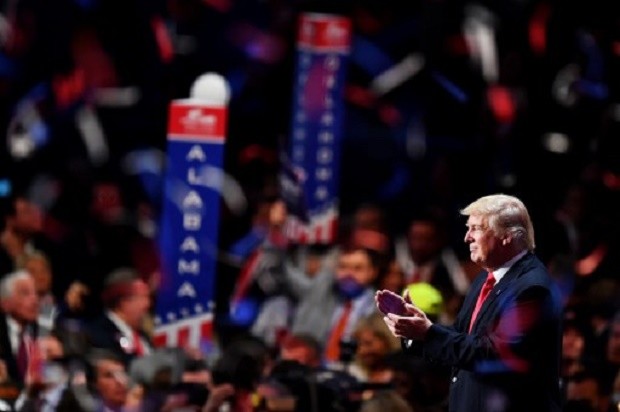
Republican presidential candidate Donald Trump acknowledges the crowd at the end of the Republican National Convention on July 21, 2016 at the Quicken Loans Arena in Cleveland, Ohio. Republican presidential candidate Donald Trump received the number of votes needed to secure the party’s nomination. An estimated 50,000 people are expected in Cleveland, including hundreds of protesters and members of the media. The four-day Republican National Convention kicked off on July 18. AFP
WASHINGTON, United States–To hear Donald Trump tell it, America is a sick, dystopian mess, mired in urban violence, terror threats and other woes that he and only he can fix.
But a day after accepting the Republican nomination for president, Trump drew scorn on Friday for his creative or misleading use of facts to paint an ugly national portrait and scare people into voting for him in November.
One of those weighing in to disagree with Trump was President Barack Obama, who said the billionaire real estate mogul’s gloomy vision and that of other Republicans at the convention this week “don’t jive with the facts.”
The United States of Armageddon, as depicted by Trump, is a place where the homicide rate and deaths of police officers are soaring, tens of thousands of dangerous undocumented immigrants wander the streets and Americans are saddled by a dysfunctional economy and quitting the workforce by the millions.
“Our convention occurs at a moment of crisis for our nation,” Trump said at the outset of his speech Thursday night in Cleveland, the most important of his young political career.
“The attacks on our police, and the terrorism in our cities, threaten our very way of life,” Trump said, a thick line of red, white and blue US flags arrayed behind him.
READ: Trump: USA will be great again
Of the whole, huge mess, he said, “I alone can fix it.”
The text of Trump’s hour-plus speech features big, sometimes half-page chunks of footnotes that the candidate offered up to buttress his assertions.
But Trump’s data was often either incomplete and thus misleading, or simply wrong.
For instance, he stated that around 180,000 undocumented immigrants with criminal records and deportation orders “are tonight roaming free to threaten peaceful citizens.”
The figure is accurate but those people’s crimes are not documented, and many of them certainly involved immigration violations and other non-violent offenses.
On the economy, among other things, he stated that US household incomes are down $4,000 since 2000.
But that figure is based on 2014 Census data, and incomes have risen sharply in the past two years, the Washington Post reported. Taking that increase into account, household income is roughly stagnant rather than down by $4,000, it added.
‘Wildly distorted view’
For Obama, “this idea that America is somehow on the verge of collapse, this vision of violence and chaos everywhere, doesn’t really jive with the experience of most people.”
Americans may disagree on how to address the nation’s problems, Obama said, “but we’re not going to make good decisions based on fears that don’t have a basis in fact.”
The Trump campaign has acknowledged that his speech was modeled on Richard Nixon’s 1968 address at the Republican convention in Miami Beach.
Nixon and his tough law and order message won the election that year, which came at a time of acute national crisis: widespread riots sweeping major American cities after the assassination of the Reverend Martin Luther King Jr and national angst over the war in Vietnam.
Not far from the White House, streets burned for days in Washington.
“We see Americans hating each other, fighting each other, killing each other at home,” Nixon said in his speech.
Trump told The New York Times recently that he saw parallels between his candidacy and that of Nixon.
“I think what Nixon understood is that when the world is falling apart, people want a strong leader whose highest priority is protecting America first,” Trump said.
“The ’60s were bad, really bad. And it’s really bad now. Americans feel like it’s chaos again.”
But America then was one thing and America now is another one altogether.
Trump’s apocalyptic vision “is not only factually false, it’s a widely distorted view of all the nation stands for,” the Times said Friday in an editorial entitled “Donald Trump’s campaign of fear.”
“One would think that if Mr. Trump believed this dystopia existed, he would have a clear and detailed plan for change. But, as always, he has only his empty sales pitch to offer — ‘I’m with you, I will fight for you, and I will win for you,’ he says.”
READ: Trump’s convention pledge to nation: Safety will be restored
The Washington Post was no less scathing.
“Donald J. Trump, until now a Republican problem, this week became a challenge the nation must confront and overcome,” it said, adding he has “unspooled one lie after another” during the campaign.
“It is impossible to know whether he convinces himself of his own untruths or knows that he is wrong and does not care,” the Post said.
“Mr. Trump is a unique and present danger.”